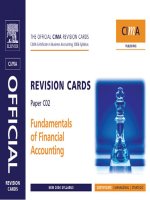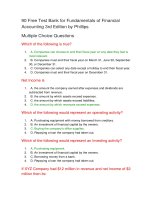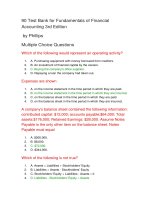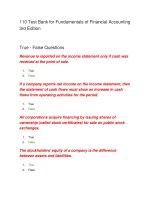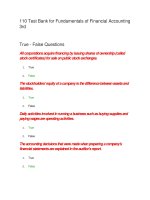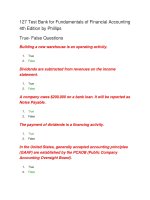CIMA revision cards fundamentals of financial accounting c02 by henry lunt
Bạn đang xem bản rút gọn của tài liệu. Xem và tải ngay bản đầy đủ của tài liệu tại đây (520.31 KB, 115 trang )
CIMA REVISION CARDS
Fundamentals of Financial Accounting
Henry Lunt
CIMA Certificate in Business Accounting C02
AMSTERDAM l BOSTON
PARIS l SAN DIEGO l
HEIDELBERG
SAN FRANCISCO
l
l
l
LONDON l
SINGAPORE
l
NEW YORK
SYDNEY
l
l
OXFORD
TOKYO
Elsevier Butterworth-Heinemann
Linacre House, Jordan Hill, Oxford OX2 8DP
30, Corporate Drive, Burlington, MA 01803
First published 2006
Copyright ß 2006, Elsevier Ltd. All rights reserved
No part of this publication may be reproduced in any material form (including photocopying or storing in any medium by electronic means and
whether or not transiently or incidentally to some other use of this publication) without the written permission of the copyright holder, except in
accordance with the provisions of the Copyright, Designs and Patents Act 1988, or under the terms of a licence issued by the Copyright Licensing
Agency Ltd, 90 Tottenham Court Road, London, England W1T 4LP. Applications for the copyright holder’s written permission to reproduce any part
of this publication should be addressed to the publisher.
Permissions may be sought directly from Elsevier’s Science & Technology Rights Department in Oxford, UK: phone: (+44) 1865 843830, fax: (+44)
1865 853333, e-mail: You may also complete your request on-line via the Elsevier homepage
(), by selecting ‘Customer Support’ and then ‘Obtaining Permissions’
British Library Cataloguing in Publication Data
A catalogue record for this book is available from the British Library
Library of Congress Cataloging in Publication Data
A catalogue record for this book is available from the Library of Congress
ISBN 10: 0 7506 8104 7
ISBN 13: 978 0 7506 8104 9
For information on all Elsevier Butterworth-Heinemann publications visit our website at
Printed and bound in Great Britain
Welcome to CIMA’s Official Revision Cards. These cards have been designed to:
.
.
.
.
.
Save you time by summarising the syllabus in a concise form
Jog your memory through the use of diagrams and bullet points
Follow the structure of the CIMA Official Learning Systems
Refer to relevant questions found within the Preparing for the Examination section of the Learning System
Provide you with plenty of exam tips and hints
Ensure exam success by revising with the only revision cards endorsed by CIMA.
TABLE OF CONTENTS
1.
2.
3.
4.
5.
6.
7.
8.
9.
10.
11.
12.
13.
14.
About the assessment ................................................................ v
The accounting scene ................................................................ 1
Framework of financial statements (FS)............................................ 7
Accounting system in action......................................................... 13
Summarising the ledger accounts .................................................. 19
Further aspects of ledger accounting............................................... 27
Accounting for non-current assets .................................................. 37
Preparation of financial statements with adjustments ............................ 43
Organising the bookkeeping system ................................................ 49
Controlling the bookkeeping system ................................................ 61
Regulatory framework ................................................................ 71
Incomplete records, I&E FS .......................................................... 79
Manufacturing a/c..................................................................... 85
Financial statements of limited companies ........................................ 91
Interpretation of financial statements ............................................... 101
About the Assessment
.
.
Taking the exam
Weighting of subjects
About the Assessment
K
K
K
K
KK
Weighting of subjects
Computer-based assessment lasting two hours
Attempt all questions. There are 50, mostly worth
2 marks each, with a few longer questions worth
4 or 6 marks
You are allowed to take a non-programmable
calculator into the assessment
You will be provided with paper for workings and
the following tables:- Logarithms; Normal
Distribution; Present Values; Cumulative Present
Values
You will also be provided with a list of key
formulae
The questions in the assessment closely mirror
the weighting of subjects
Conceptual and regulatory framework
Accounting systems
Control of accounting systems
Preparation of accounts for single
entries
20%
20%
15%
45%
Try the online demo at www.cimaglobal.com/mail/
prospective/where/studying/cba or purchase the
interactive testing CD’s at www.cimapublishing.com
The Accounting Scene
Examining the objectives of accounting information
Topics
Key learning
system questions
1.12
1.13
Users
Characteristics
.
.
.
.
Who uses financial statements (FS)?
Qualitative characteristics of FS
Financial vs management accounting
What is a business organisation?
1
The Accounting Scene
Who uses FS?
KKKKKKKKK
User groups
Existing and potential shareholders
Existing and potential lenders
Employees
Analysts
Customers
Suppliers
Government
General public
Strategic/Tactical/Operational management
Definition
Accounting provides information (financial
position, performance and cash flow) regarding
the business to its users
Study tip
Learn definitions, as many form the basis
for single part questions
2
The Accounting Scene
Qualitative characteristics of FS
KKKKKKK
Features include:
Accuracy
Reliability
Relevance
Timeliness
User friendliness
Comparability
Cost-effectiveness
Definition
Exception reporting – giving information to
management on a need to know basis only
3
The Accounting Scene
Financial vs management accounting
K
KKKK
Financial accounting is generally:
External rather than internal information
Produced on an annual basis
Subject to precise layouts and legislation
Summarised to protect the interests
of the business
Measured in monetary terms
Definitions
Bookkeeping – recording monetary transactions
of a business
Financial accounting – classifying monetary
transactions according to guidelines and
presenting the information in appropriate
statements
Management accounting – processing of
information to facilitate planning, control and
decision making
4
The Accounting Scene
Profit-making organisations
Definition
KKKK
What is a business organisation?
Business – an entity that enters into transactions
that are expected to result in the achievement of
monetary aims
Sole traders
Partnerships
Private limited companies
Public limited companies
KKK
Non-profit-making organisations
Central and local government
Charities
Clubs and societies
5
This page intentionally left blank
Framework of Financial
Statements (FS)
Examining the basic concepts involved in the preparation of FS
Topics
Key learning
system questions
3.2
Key features
.
.
.
.
Basic concepts
The balance sheet
The income statement
Key features
7
Framework of FS
Basic concepts
Separate entity concept
For accounting purposes, the business is
treated as a separate entity from the owner(s) of it.
Thus the accounting information reflects the
activities of the business only
Study tip
Don’t underestimate the importance of this
equation. It is particularly useful for incomplete
records questions
Accounting equation
It is always true that assets equal liabilities plus
capital. This fundamental statement forms the
basis for the preparation of the accounting records
and financial statements. When rearranged, the
equation forms the basis of the balance sheet
presentation, i.e.
Assets ¼ Capital þ Liabilities
8
Framework of FS
Basic concepts
Definitions
Assets – resources used by the business in
order to gain future revenue. They may be held
on a long-term basis e.g. buildings (tangible
non-current) and goodwill (intangible non-current
assets); or held on a short-term basis (current
assets) e.g. receivables and inventories
Study tip
It is essential that these terms be thoroughly
understood
Liabilities – obligations of the business to transfer
economic benefit as a result of past events. These
may also be non-current (more than one year) or
current (less than one year) and include payables
and bank overdraft
Capital – a specific kind of liability that relates
to the owners’ investment in the business
9
Framework of FS
The balance sheet
HiTech Engineering
Balance Sheet as at date
Assets
Non-current assets
Buildings
Equipment
$000
$000
X
X
Non-current liabilities
Bank loan
Current liabilities
Trade payables
Other payables
X
X
X
X
X
X
Note
X
X
X
You should study this layout very carefully
X
X
Capital and liabilities
Capital
X
You should note:
KKK
Current assets
Inventories
Receivables
Bank/cash
The name of the business
The title – balance sheet as at date
The currency – $000
10
Framework of FS
K
KK
The income statement
The headings, e.g. Assets, Capital
The inset of figures, e.g. buildings and equipment
The underlining and sub-totals
HiTech Engineering
Income statement for year
ending date
Sales
Opening inventories
Purchases
Closing inventories
Cost of goods sold
Gross profit
Less expenses
Net profit
$000
$000
X
Note
Sales represents the revenue generated from
trading and to get to a gross profit then the cost
of those items sold must be established. To arrive
at the net profit then business expenses are
deducted. Remember that drawings do not
represent expenses in a sole trader’s business
but are shown in the balance sheet as a reduction
in capital
X
X
(X)
X
X
X
X
11
Framework of FS
Key features
Profits and cash
KK
K
It is important to recognise that a business may be
profitable but not necessarily increase its cash
supply. This can be due to many reasons but
includes:
Not all customers will pay cash but remain
as receivables on the balance sheet
Suppliers may remain unpaid as payables
Cash drawings only impact the capital figure
in the balance sheet
Study tip
This distinction between profit and cash is particularly important when looking at the cash-flow
statement
Capital and revenue
Capital transactions relate to items that enhance the
long-term economic benefits of the business, e.g.
purchase or disposal of non-current assets. These
are shown on the balance sheet (BS)
Revenue transactions relate to items that are
consumed in the period, e.g. running expenses.
These are shown in the income statement(IS)
12
Accounting System in
Action
Examining the accounting system together with sales,
purchases and nominal ledger accounting
Key learning
system questions
1.1
2.1
3.5
28
Double
Double
Double
Double
entry
entry
entry
entry
Topics
.
.
Double entry
Balancing off the ledger accounts
13
Accounting System in Action
Double entry
General rules
Study tip
DR
CR
Asset/Expense
Liability/Capital/Revenue
Vice versa for decreases
14
Accounting System in Action
Double entry
Trade goods – purchases
Trade goods – sales
Purchases a/c
Payable
Receivable a/c
$
X
Sales
$
X
Sales a/c
Payable a/c
$
Purchases
$
X
$
Receivable
$
X
15
Accounting System in Action
Double entry
Definitions
Ledger a/c – single record of transactions represented by debits (DR) on the left and credits (CR)
on the right – also known as a T a/c
Double entry bookkeeping – system of record
keeping involving the concept of duality, i.e. every
transaction has two equal and opposite effects
Nominal ledger – main ‘book’ of records
Columnar ledger a/cs – alternative layout, similar
to bank statement style a/cs
16
Accounting System in Action
Balancing off the ledger accounts
K
Purpose
To establish a balance at any point in time
Study tip
Practice makes perfect!
K
K
KKK
Calculation
Add the figures on each side
Enter the larger amount in as a total
Balance the opposite side by entering the
balancing figure
This represents either a balance carried forward
(bal c/f) or transfer to the income statement
Bal c/f figures are then written as bal b/f on
the opposite side
17
This page intentionally left blank
